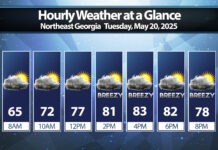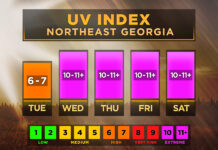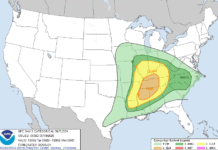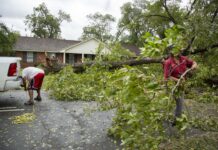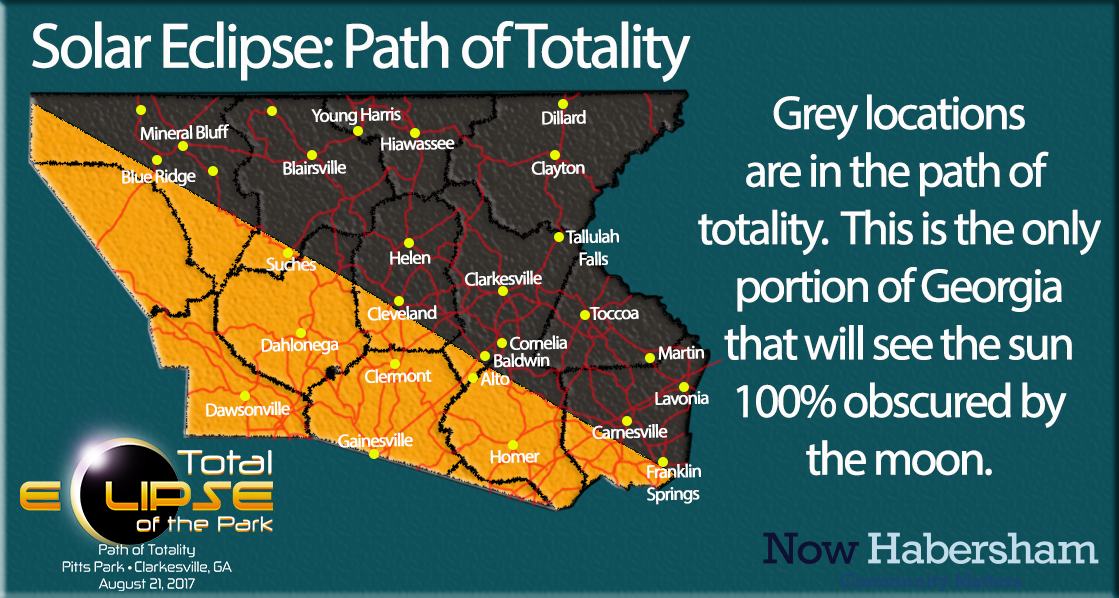
August 21, 2017 will be a very special day across Northeast Georgia. It has been hundreds of years since the sun last completely disappeared behind the moon across Northeast Georgia, but that’s about to change.
At 2:36:22 PM EDT on August 21, the sun will slip entirely behind the moon, revealing the sun’s corona amidst and many stars during the middle of the day. This will last for a very short 1 minute 43.1 seconds before the sun comes back out the other side. The partial solar eclipse on either side of the totality will last from 1:06PM to 4:01PM.
This will be a day that goes down in history, so let’s talk a bit about it.
What is a solar eclipse?
A solar eclipse occurs when the moon passes between the sun and the Earth. There are four main types of solar eclipses: partial, annular, total and hybrid.

What is a partial eclipse?
A partial eclipse is when the sun is only partially covered by the moon. North Georgia last witnessed one of these in October of 2014 and they are quite common. That said the next one of these we will see comes in 2023.

What is an annular eclipse?
Because the moon’s orbit isn’t perfectly circular, it can be varying distances from the Earth during an eclipse. This makes it’s diameter larger or smaller (larger when close, smaller when far). Occasionally eclipses occur when the moon is far enough away it appears smaller than the sun. When this happens, the moon doesn’t completely block out the sun, but rather causes it to appear like a ring (or “annulus”). These eclipses are known as Annular and are much rarer than partials.

What is a total solar eclipse?
A total solar eclipse, however, is a truly amazing and rare treat. During a total eclipse the moon completely blocks out the sun, causing darkness over a tiny spot of Earth’s surface. In the area of totality, the sun’s corona becomes visible and this is the ONLY time it is ever visible to the naked eye. The sun doesn’t have a true solid surface, but it does have a “visible surface”, where it appears to end. The sun’s atmosphere lies outside this, and the outer layers of this are called the corona. During a total solar eclipse this region is visible, and large plumes of gas can be seen being warped in all directions by the sun’s magnetic sphere.

Also during a total eclipse most of the brighter stars become visible, mainly those away from the sun, along with any bright planets that are up. There are several other phenomenon that happen during a total eclipse, and you can find out about them below.
What is a hybrid eclipse?
A hybrid eclipse is quite rare and occurs when an annular eclipse becomes a total eclipse. As I mentioned before, the distance from the earth to the moon varies, and occasionally this is so finely balanced that an annular eclipse gradually shifts into a total eclipse.
What phenomena should I watch for?
If the sun being blocked out by the moon isn’t enough for you, there are several things to watch for during the moments before/during/after totality. The first is called Bailey’s Beads. The moon doesn’t have a flat surface, but rather fairly tall mountains. As the moon slides in front of the sun for a few brief seconds the sun shines through gaps in the mountains, causing “beads” to appear around the edges. This gives the look of a diamond necklace hanging in the sky. When only one bead is left comes the most spectacular moment of all: the diamond ring effect. For a brief moment the eclipse will appear as a diamond ring. These happen at both the beginning and end of totality, and the diamond ring effect usually only lasts for a couple of seconds.

Another phenomenon to watch for are solar prominences. These will appear just outside the silhouette of the moon, and they are areas of gas being carried up by the sun’s strong magnetic sphere. They form loops and streams just off the surface. Streams are also visible in the corona. Major prominences don’t happen with every eclipse, and there is really no way to predict whether any will be visible or not. Fortunately for us here on the east coast, by the time totality reaches us we will have images from the west coast to go by.
One final phenomenon to watch for occurs during the partial eclipse, particularly in the time around totality. Since the eclipse is occurring during the summer months, there will be plenty of leaves on the trees. The gaps between the leaves will act as thousands of pinhole cameras (read more about those below), and project the image of the eclipse onto the ground and other objects.
How can I watch the eclipse?
First off, NEVER look at the sun with the naked eye as it is extremely dangerous. The brightness can quickly damage your eyes, even during a partial eclipse. This problem can make viewing an eclipse somewhat difficult, but there are two easy methods we can use to see it. The first is the easiest: eclipse glasses. These are mass produced and you can order them online, and are basically just very dark film that blocks out 99% of the sun’s light leaving a still plenty-visible 1% to see. A lot of welding helmets can also be used in the same way. During totality it is safe to look at the sun with the naked eye, and in fact this will be the only way to view solar prominences and the corona.
If you don’t have access to eclipse glasses, a pinhole camera is by far the easiest way to go. The easiest pinhole camera consists of two pieces of white paper (construction paper, paper plates or card stock is best). Simply place one piece on the ground, poke a hole in another and let the sun shine through the hole onto the paper on the ground. During the eclipse, the shadow will appear as the sun looks through eclipse glasses. The leaves on the trees will also accomplish this effect, allowing you to see the eclipse even without access to paper. Look out for a video from Now Habersham soon demonstrating how to make and use a pinhole camera.
What if it’s cloudy?
This is the age old problem we run into across North Georgia. The past 6 lunar eclipses have been blocked by clouds across Northeast Georgia, and a solar eclipse in August is quite possible to suffer the same fate. Climatology shows over a 50% chance of at least some clouds interfering, but with any luck they won’t be around during totality across Habersham County.
Where can I watch from?
Your home! 99% of Habersham County will be in the area of totality, with Cornelia sitting just a couple miles inside the shadow. The totality line ends between Baldwin and Alto, and the closer you are to it the shorter the duration of totality will be. Cleveland, Clayton and Young Harris will also be inside the shadow. Dahlonega, Gainesville, and Commerce will see the sun 99% covered, but will not see a true total solar eclipse. The eclipse path runs across the entire U.S., and you can see the full path below.

There are many events planned for this day locally including one with Now Habersham in Clarkesville. Total Eclipse of the Park will be a community viewing party for the eclipse featuring live music, food vendors and other activities. We’ll also have commemorative t-shirts and eclipse glasses available.
We’ll be sharing more information on the eclipse as it draws closer, so stay tuned. Watch the skies!




